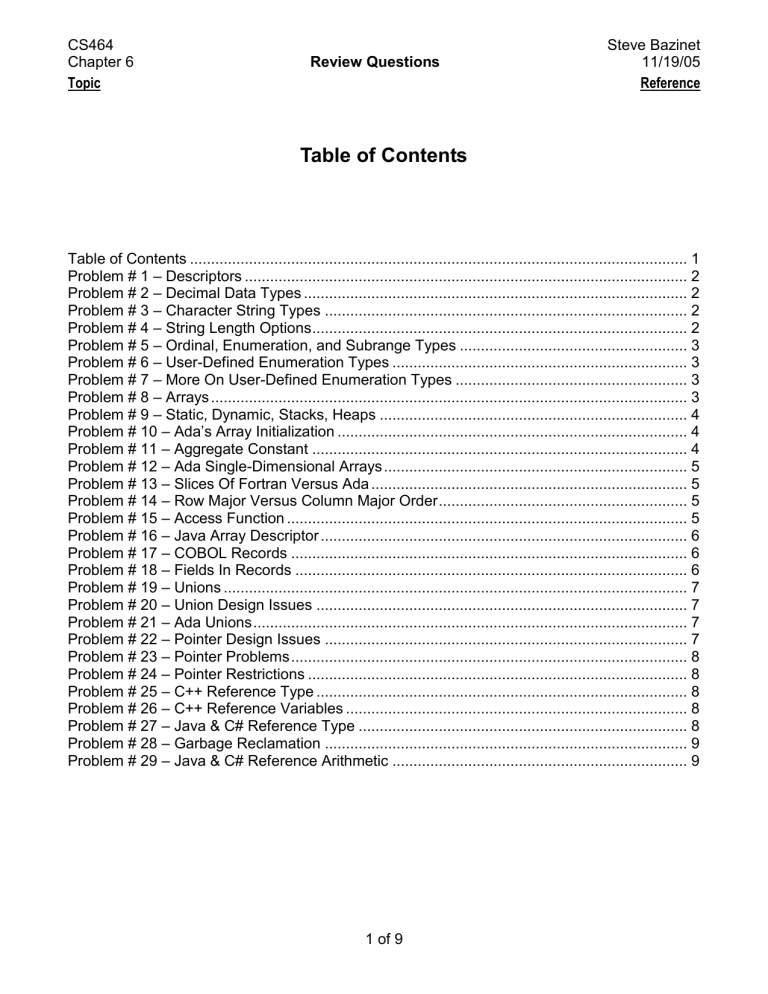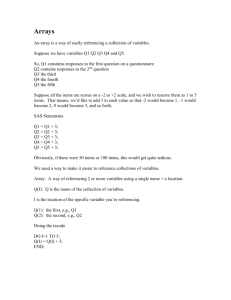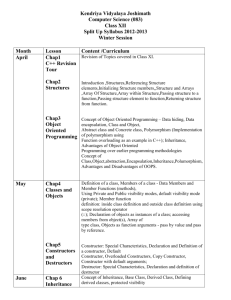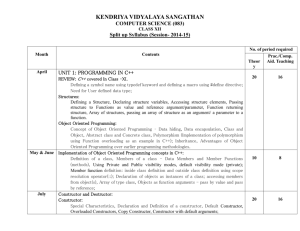Chapter 6 - Review Questions

CS464
Chapter 6
Topic
Review Questions
Steve Bazinet
11/19/05
Reference
Table of Contents
– More On User-Defined Enumeration Types ....................................................... 3
1 of 9
CS464
Chapter 6
Topic
Review Questions
Steve Bazinet
11/19/05
Reference
Problem # 1
– Descriptors
What is a descriptor? p. 253
It is convenient, both logically and concretely, to think of variables in terms of descriptors. A descriptor is the collection of the attributes of a variable.
More detail: In an implementation, a descriptor is a collection of memory cells that store variable attributes. If the attributes are all static, descriptors are required only at compile time. These descriptors are built by the compiler, usually as a part of the symbol table, and are used during compilation. For dynamic attributes, however, part or all of the descriptor must be maintained during execution. In this case, the descriptor is used by the run-time system. In all cases, descriptors are used for type checking and to build the code for the allocation and deallocation operations.
Problem # 2
– Decimal Data Types
What are the advantages and disadvantages of decimal data types? p. 255
Decimal data types store a fixed number of decimal digits, with the decimal point at a fixed position in the value. Decimal types have the advantage of being able to precisely store decimal values, at least those within a restricted range, which cannot be done with floatingpoint.
The disadvantages of decimal types are that the range of values is restricted because no exponents are allowed, and their representation in memory is wasteful.
Problem # 3
– Character String Types
What are the design issues for character string types? p. 257
A character string type is one in which the values consist of sequences of characters. The two most important design issues that are specific to character string types are the following:
Should strings be simply a special kind of character array or a primitive type (with no arraystyle subscripting operations)?
Should strings have static or dynamic length?
Problem # 4
– String Length Options
Describe the three string length options. p. 259
A static length string is a string whose length is static and set when the string is created.
A limited dynamic length string is a string that has a varying length up to a declared and fixed maximum set by the variable’s definition. Such string variables can store any number of characters between zero and the maximum.
A dynamic length string is a string that has a varying length and no maximum. This option requires the overhead of dynamic storage allocation and deallocation but provides maximum flexibility.
2 of 9
CS464
Chapter 6
Topic
Review Questions
Steve Bazinet
11/19/05
Reference
Problem # 5
– Ordinal, Enumeration, and Subrange Types
Define ordinal , enumeration , and subrange types . p. 261
An ordinal type is one in which the range of possible values can be easily associated with the set of positive integers. In Java, for example, the primitive ordinal types are integer , char , and boolean .
An enumeration type is one in which all of the possible values, which are named constants, are provided in the definition. Enumeration types provide a way of defining and grouping collections of name constants, which are called enumeration constants. An example in C#: enum days {Mon, Tue, Wed, Thu, Fri, Sat, Sun};
A subrange type is a contiguous subsequence of an ordinal type. For example,
12 .. 14 is a subrange of integer type. p. 264
Problem # 6
– User-Defined Enumeration Types
What are the advantages of user-defined enumeration types?
p. 264
Enumeration types can provide advantages in both readability and reliability. Readability is enhanced in a very direct way. Named values are easily recognized, whereas coded values are not. In the area of reliability, the enumeration types of Ada, C#, and Java 5.0 provide two advantages. First, no arithmetic operations are legal on enumeration types. Second, no enumeration variable can be assigned a value outside its defined range.
Problem # 7 – More On User-Defined Enumeration Types
In what ways are the user-defined enumerations types of C# more reliable than those of C++?
The enumeration types in C# are better than those of C++, because enumeration type variables in C# are never coerced to integer types.
Problem # 8
– Arrays
What are the design issues for arrays?
What types are legal for subscripts?
Are subscripting expressions in element references range-checked?
When are subscript ranges bound?
When does array allocation take place?
Are ragged or rectangular multidimensioned arrays allowed, or both?
Can arrays be initialized when they have their storage allocated?
What kinds of slices are allowed, if any? p. 264 p. 266
3 of 9
CS464
Chapter 6
Topic
Review Questions
Steve Bazinet
11/19/05
Reference
Problem # 9 – Static, Dynamic, Stacks, Heaps
Define static , fixed stack-dynamic , stack-dynamic , fixed heap-dynamic , and heap-dynamic arrays . What are the advantages of each? p. 268
A static array is one in which the subscript ranges are statically bound and storage allocation is static (done before run time). The advantage of static arrays is efficiency:
No dynamic allocation or deallocation is required.
A fixed stack-dynamic array is one in which the subscript ranges are statically bound, but the allocation is done at declaration elaboration time during execution. The advantage of fixed stack-dynamic arrays over static arrays is space efficiency.
A stack-dynamic array is one in which the subscript ranges are dynamically bound and the storage allocation is dynamic (done during run time). One the subscript ranges are bound and the storage is allocated, however, they remain fixed during the lifetime of the variable. The advantage of stack-dynamic arrays over static and fixed stack-dynamic arrays is flexibility. The size of an array need not be known until the array is about to be used.
A fixed heap-dynamic array is similar to the fixed stack-dynamic array, in that the subscript ranges are dynamically bound and the storage binding is dynamic, but they are fixed after storage is allocated. The differences are that the bindings are done when the user program requests them, rather than at elaboration time, and the storage is allocated from the heap, rather than the stack. Assumption (not stated in text): The advantage of fixed heap-dynamic arrays is space efficiency.
A heap-dynamic array is one in which the binding of subscript ranges and storage allocation is dynamic and can change any number of times during the array’s lifetime.
The advantage of heap-dynamic arrays over the others is flexibility.
Problem # 10
– Ada’s Array Initialization
What array initialization feature is available in Ada that is not available in other common imperative languages? p. 271
In Ada one can directly assign a value to an index position using the => operator, which in Ada is called an arrow . For example,
List : array (1..5) of Integer := (1 => 17, 3 => 34, others => 0);
Problem # 11
– Aggregate Constant
What is an aggregate constant?
A parenthesized list of values used in initializing arrays is called an aggregate value . I couldn’t find a reference to the term “aggregate constant” in the text nor on the ‘net.
p. 271
4 of 9
CS464
Chapter 6
Topic
Review Questions
Steve Bazinet
11/19/05
Reference
Problem # 12 – Ada Single-Dimensional Arrays
What array operations are provided specifically for single-dimensioned arrays in Ada? p. 271
Ada allows array assignments, including those where the right side is an aggregate value rather than an array name. Ada also provides catenation, specified by the ampersand (&).
Catenation is defined between two single-dimensioned arrays and between a singledimensioned array and a scalar. Nearly all types in Ada have the built-in relational operators for equality and inequality.
Problem # 13 – Slices Of Fortran Versus Ada
What are the differences between the slices of Fortran 95 and those of Ada? p. 273
A slice of an array is some substructure of the array. In Ada, only highly restricted slices are allowed: those that consist of consecutive elements of a single-dimensioned array. In Fortran
95, slicing is much more flexible. They can be any row, column, parts of rows, parts of columns, groups of rows, or groups of columns. One can even select every n th column in a row.
Problem # 14
– Row Major Versus Column Major Order
Define row major order and column major order . p. 275-6
There are two common ways in which multidimensional arrays can be mapped to one dimension: row major order and column major order. In row major order , the elements of the array that have as their 1 st subscript the lower bound value of that subscript are stored first, followed by the elements of the second value of the first subscript, and so forth. In column major order , the elements of an array that have as their last subscript the lower bound value of that subscript are stored first, followed by the elements of the second value of the last subscript, and so forth.
3 4 7 would be stored in row major order as 3,4,7,6,2,5,1,3,8.
6 2 5 would be stored in column major order as 3,6,1,4,2,3,7,5,8.
1 3 8
Problem # 15
– Access Function
What is an access function for an array? p. 276-7
An access function for a multidimensional array is the mapping of its base address and a set of index values to the address in memory of the element specified by the index values. For example, this is the access function for a two-dimensional array stored in row major order where a[1,1] is the base address: location( a[i,j]= address of a[1,1] +
((((# of rows above i th row) * (size of a row))
+ (# of elements left of the j th column)) * element size
5 of 9
CS464
Chapter 6
Topic
Review Questions
Steve Bazinet
11/19/05
Reference
Problem # 16 – Java Array Descriptor
What are the required entries in a Java array descriptor, and when must they be stored (at compile time or run time)? p. 269
In Java all arrays are fixed heap-dynamic arrays. Once created, these arrays keep the same subscript ranges and storage. Secondarily, Java supports jagged arrays and not rectangular arrays. Being a fixed heap-dynamic array the entries will be established and fixed at run time.
Array
Element type
Index type index lower bound index upper bound address
If multiple-dimensional this will be of type Array object.
This is not shown directly in the text that I can see. Should be a problem!
If I get a chance I’ll write a program to get the info by using Descriptor object in the javax.management package.
Problem # 17
–
COBOL Records
What is the purpose of level numbers in COBOL records p. 284-5
The level numbers in COBOL records are used to establish a hierarchical structure of related records. This is most easily illustrated with an example.
01 EMPLOYEE-RECORD
02 EMPLOYEE-NAME.
05 FIRST PICTURE IS X(20).
05 MIDDLE PICTURE IS X(20).
05 LAST PICTURE IS X(20).
02 TITLE PICTURE IS X(30).
02 HOURLY-RATE PICTURE IS 99V99.
The highest or largest record is the EMPLOYEE record. It consists of three fields on the 02 level; the employee’s name, title, and hourly rate. The employee’s name is further broken down into the three fields on the 05 level; first name, middle, and last.
Problem # 18
–
Fields In Records
Define fully qualified and elliptical references to fields in records. p. 286
A fully qualified reference to a record field is one in which all intermediate record names, from the largest enclosing record to the specific field, are named in the reference. For example, Employee.EmployeeName.First
is a fully qualified reference to an employee’s first name.
In an elliptical reference , the field is named, but any of the enclosing record names can be omitted, as long as the resulting reference is unambiguous in the referencing environment.
6 of 9
CS464
Chapter 6
Topic
Review Questions
Steve Bazinet
11/19/05
Reference
Problem # 19 – Unions
Define union , free union , and discriminated union . p. 288-9
A union is a type that may store different type values at different times during program execution. It’s address is one location and its length is the longest type that it needs to store.
Some union are called free unions because programmers are allowed complete freedom from type checking in their use.
Type checking of unions requires that each union construct include a type indicator. Such an indicator is called a tag, or discriminant, and a union with a discriminant is called a discriminated union .
Problem # 20
–
Union Design Issues
What are the design issues for unions? p. 288
The primary design issues that are particular to union types are the following:
Should type checking be required? Note that any such type checking must be dynamic.
Should unions be embedded in records?
Problem # 21 – Ada Unions
Are the unions of Ada always type checked? p. 289
Yes, but in two different ways. In one way the user is allowed to specify which types are allowed in the union. When using the union at run time (dynamically) only previously specified types are allowed to be used in the union.
In the other way, however, the union can be changed but it must be changed completely by assigning an entire record, including the discriminant. This disallows inconsistency because the newly assigned record was already checked at compile time (statically) for consistency.
Problem # 22
–
Pointer Design Issues
What are the design issues for pointer types?
The primary design issues particular to pointers are the following:
What are the scope and lifetime of a pointer variable?
What is the lifetime of a heap-dynamic variable?
Are pointers restricted as to the type of value to which they can point?
Are pointers used by dynamic storage management, indirect addressing, or both?
Should the language support pointer types, reference types, or both? p. 292
7 of 9
CS464
Chapter 6
Topic
Review Questions
Steve Bazinet
11/19/05
Reference
Problem # 23 – Pointer Problems
What are the two common problems with pointers? p. 294-5
One common problem with pointers is the dangling pointer , or dangling reference which is a pointer that contains the address of a heap-dynamic variable that has been deallocated.
The common problem is a lost heap-dynamic variable which is an allocated heap-dynamic variable that is not longer accessible to the user program, i.e. it hasn’t a pointer. Such variables are called garbage because they are unusable.
Problem # 24 – Pointer Restrictions
Why are the pointers of most languages restricted to pointing at a single type variable? p. 296-7
The main reason for this is pointer arithmetic. For example, if ptr is a pointer variable that is declared to point at some variable of some data type, then ptr + index is a legal expression. The semantics of such an expression is as follows. Instead of simply adding the value of index to ptr , the value of index is first scaled by the size of the memory cell (in memory units) to which ptr is pointing (its base type). For example, if ptr points to a memory cell for a type that is four memory units in size, then index is multiplied by 4, and the result is added to ptr . The primary purpose of this sort of address arithmetic is array manipulation.
Problem # 25
–
C++ Reference Type
What is a C++ reference type and what is its common use? p. 298-9
C++ includes a special kind of pointer type, called a reference type . It is used primarily for the formal parameters in function definitions. A C++ reference type variable is a constant pointer that is always implicitly dereferenced.
Problem # 26
– C++ Reference Variables
Why are reference variables in C++ better than pointers for formal parameters? p. 298
Because a C++ reference type variable is a constant, it must be initialized with the address of some variable in its definition, and after initialization a reference type variable can never be set to reference any other variable.
Problem # 27
– Java & C# Reference Type
What advantages do Java and C# reference type variables have over the pointers in other languages? p. 300
The references of Java and C# provide some of the flexibility and the capabilities of pointers, without the hazards. It remains to be seen whether programmers will be willing to trade the full power of C and C++ pointers for the greater safety of references.
8 of 9
CS464
Chapter 6
Topic
Review Questions
Steve Bazinet
11/19/05
Reference
Problem # 28 – Garbage Reclamation
Describe a lazy and eager approaches to reclaiming garbage. p. 302-3
The lazy approach or garbage collection is when reclamation only occurs when the list of available space becomes empty. With this method, the run-time system allocates storage cells as requested and disconnects pointers from cells as necessary without regard for the storage reclamation (allowing garbage to accumulate), until it has allocated all available cells. At this point, a garbage collection process is begun to gather all the garbage left floating around in the heap.
The eager approach or reference counter method is incremental and is done when inaccessible cells are created. This method of reclamation accomplishes its goal by maintaining in every cell a counter that stores the number of pointers that are currently pointing at the cell. When the reference counter reaches zero, it means that no program pointers are pointing at the cell, and it has thus become garbage and can be returned to the list of available space.
Problem # 29
– Java & C# Reference Arithmetic
Why wouldn’t arithmetic on Java and C# references make sense? p. 299
Java and C# references refer to class instances and not memory addresses. This immediately presents arithmetic on these references from being sensible.
9 of 9







